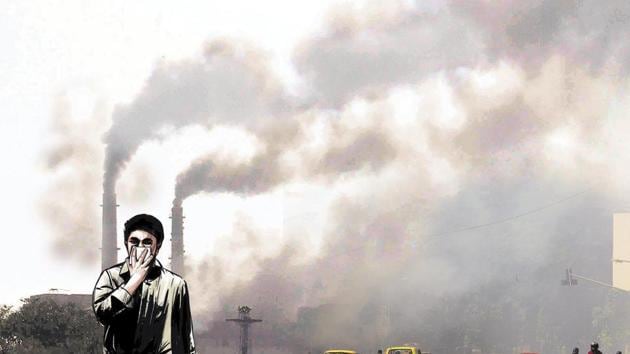Concentration of carbon dioxide over India is on the rise: Study
In May, CO2 levels in the Earth’s atmosphere crossed 415ppm (parts per million) for the first time in recorded history.
The concentration of carbon dioxide (CO2) over India is consistently on the rise, according to a study. Findings of a five-member team led by the University of Delhi’s Rajdhani College show that every year, the CO2 level in the mid-tropospheric region – 5km to 8km from Earth’s surface – increases by 2.01ppm (parts per million) over the country every year, touching a high of around 5ppm during summer and a low of 1ppm after the monsoon, owing to the increase in green cover.

The study is based on data from the Atmospheric Infra-Red Sounder (AIRS) on board NASA’s Aqua satellite that analysed the annual mid-tropospheric CO2 concentration from 2003 to 2011. A recent analysis of the AIRS data by the study’s lead author professor Surendra K Dhaka shows the rate of increase – 2.01ppm per year – has remained steady till 2017. This means, CO2 level in the lowest layer of Earth over India has gone up by 28.14ppm in the 2003-2017 period.
In May, CO2 levels in the Earth’s atmosphere crossed 415ppm (parts per million) for the first time in recorded history.
It was based on data from the Mauna Loa Observatory in Hawaii – 350ppm is considered safe. India is the third largest emitter of CO2 after China and US.
“Emissions from industries, vehicles and burning coal to generate electricity and biomass burning increase CO2 levels close to the Earth’s surface. We, therefore, analysed CO2 concentration in the troposphere because it directly affects us,” said Dhaka, also associate professor, radio and atmospheric laboratory, department of physics, Rajdhani College. “The CO2 that we emit finally makes its way in to the atmosphere.”
The study – supported by ISRO/Department of Space – is published in the peer-reviewed Journal of Earth Systems Science of the Indian Academy of Sciences. The findings were also presented at the 42nd Assembly of the Committee on Space Research held in US last year.
Yogesh K Tiwari, scientist, Indian Institute of Tropical Meteorology at Pune, who was not involved in the study, said that in addition to an increase in CO2 levels due to local antropogenic and natural emissions owing to a rise in emissions over India, there is also background net CO2 concentration already present in the atmosphere.
“In addition to anthropogenic emissions, CO2 further increases due to drought during El Nino, stubble burning, forest fires, etc because of less biosphere bloom at the earth’s surface, potential of CO2 sink reduces significantly. If we continue emitting more CO2 and other greenhouse gases, temperature may further increase in the long run. Present CO2 level is already alarming, so further a increase is not safe,” said Tiwari. “We need clean cutting-edge technologies that emit less CO2, to explore better carbon-capture and storage mechanism, reduce deforestation and increase afforestation so that the biosphere, which is a natural sink can persist.”
The analysis found that the CO2 concentration was highest at 5ppm in April–May, and decreased by 3ppm during the monsoon. It reaches the lowest at around 1ppm in October-November.
During the dry summer months of April and May, convection lifts the warm air, including the polluting gas, thereby increasing CO2 concentration in the mid-troposphere.
“The seasonal decrease in CO2 concentration during and after the monsoon season is a combination of three factors – reduced outgoing long-wave radiation due to cloud cover that cuts sunlight, rainfall over most parts of India and associated increase in vegetation. The growth in vegetation acts as a sink for CO2 concentration through increased photosynthesis over a large region,” said Dhaka. “CO2 levels, however, begin to gradually rise again in November, through the winter months and peaks till April owing to a lack of vegetation and therefore reduced photosynthesis, as well as crop burning activities.”
Across India, a gradual increase in CO2 concentration takes place from the north extending to southeast during peak summer months of March to May.
North India records twin peaks in CO2 concentration during summer and late winter. The pollutant enhances in summer owing to lack of vegetation and strong transfer of heat (convection) that pushes CO2 concentration from the lower to middle troposphere. “During late winter season, larger variation in CO2 concentration in the northern region suggests larger anthropogenic activities, probably burning of agriculture waste in countryside is adding to such a scenario,” stated the study.
In contrast, southern parts of India receive both southwest and north-east monsoon which leads to an increase in vegetation during August-September and February respectively, resulting in low CO2 concentration.
The study also observed a “striking difference” of 3-5ppm in CO2 concentration over land and ocean. CO2 concentration is stronger during July to November over the Indian Ocean when landmass experiences low concentration, while low concentration is seen over the Arabian Sea during winter season.
Stay updated with all the Breaking News and Latest News from Mumbai. Click here for comprehensive coverage of top Cities including Bengaluru, Delhi, Hyderabad, and more across India along with Stay informed on the latest happenings in World News.
Stay updated with all the Breaking News and Latest News from Mumbai. Click here for comprehensive coverage of top Cities including Bengaluru, Delhi, Hyderabad, and more across India along with Stay informed on the latest happenings in World News.





